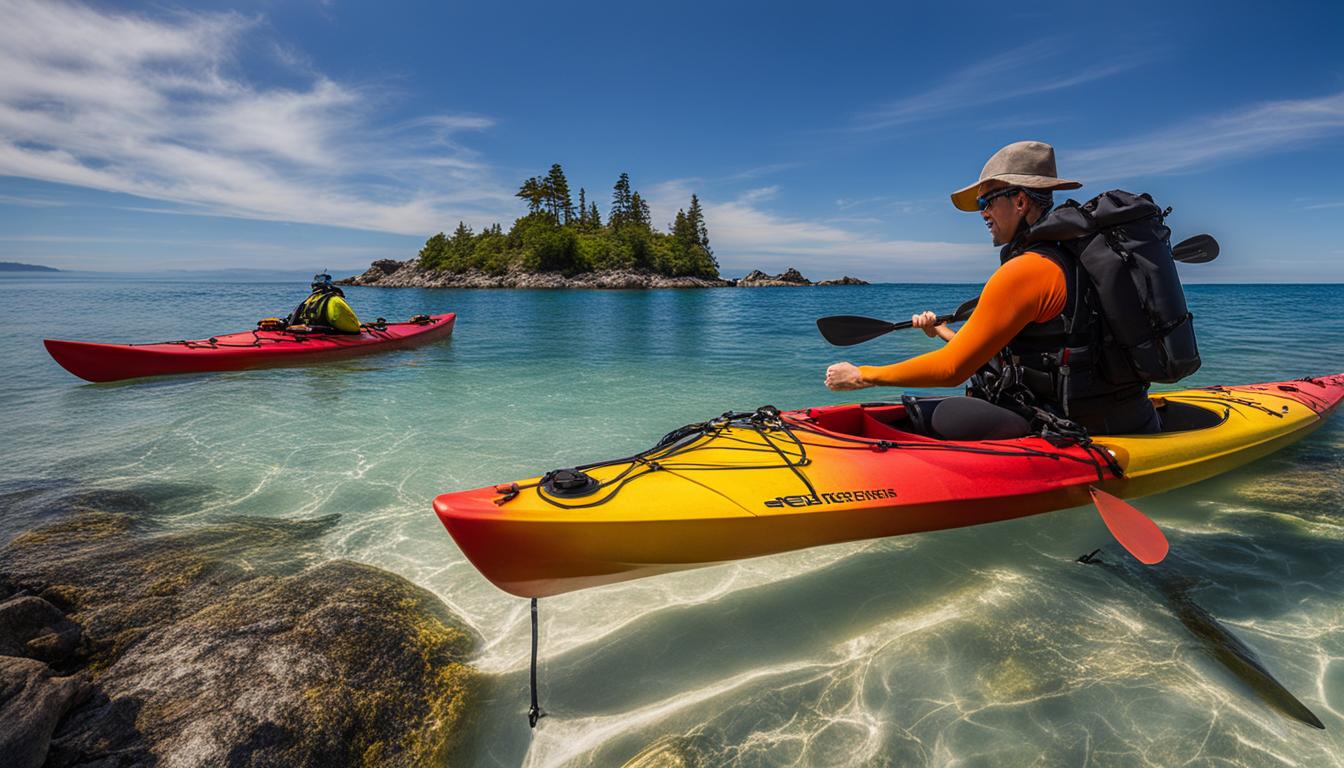Welcome to the world of kayaking, where adventure awaits! Whether you’re a seasoned paddler or a newbie looking to explore the waters, renting a kayak is a convenient and cost-effective option. But before you hit the waves, it’s essential to understand the ins and outs of kayak rental agreements and insurance.
Rental agreements and insurance play a crucial role in ensuring a smooth and safe kayaking experience. From understanding the terms and conditions of rental contracts to choosing the right insurance coverage, being well-informed is key. This article will provide you with valuable insights into the important aspects of kayak rental agreements and insurance options.
Key Takeaways:
- 1. Rental agreements and insurance are essential for the smooth operation of kayak rentals.
- 2. Understanding the terms and conditions of rental contracts is crucial for a hassle-free experience.
- 3. Choosing the right insurance coverage protects you from potential liabilities and risks.
- 4. Rental agreements and insurance go hand in hand to ensure your safety and peace of mind.
- 5. Being well-informed about rental agreements and insurance options helps you make informed decisions and enjoy your kayaking adventures.
Rent for Storage Facilities
When running a kayak rental business, one of the significant costs to consider is the rent for storage facilities. These facilities provide a safe and secure space to store the kayaks when they are not in use, ensuring their longevity and minimizing the risk of damage or theft.
The average monthly rent for storage facilities in the United States ranges from $50 to $500. However, the cost can vary depending on various factors such as the location, size, and amenities provided by the facility. It’s important to carefully consider these factors and choose a facility that aligns with your business needs and budget.
Location plays a crucial role in determining the cost of storage facilities. Facilities located in prime areas or near popular kayaking destinations may have higher rent due to increased demand. On the other hand, facilities located further away from such areas may offer lower rent but could potentially impact customer convenience and accessibility.
Factors Affecting the Cost of Storage Facilities:
- Location: Facilities located in popular or prime areas may have higher rent.
- Size: Larger storage units will generally cost more than smaller ones.
- Amenities: Facilities offering additional amenities such as 24-hour access, climate control, and security systems may have higher rent.
It’s crucial to carefully evaluate your business requirements and choose a storage facility that strikes the right balance between cost, convenience, and security for your kayaks.
| Factors | Average Monthly Rent Range |
|---|---|
| Location | $50 – $500 |
| Size | Varies based on square footage |
| Amenities | Additional charges may apply |
By carefully considering the factors affecting the cost of storage facilities and choosing the right facility for your business, you can effectively manage this expense and ensure the safety and security of your kayaks.
Cost of Purchasing or Leasing Kayaks
When it comes to starting a kayak rental business, one of the major considerations is the cost of purchasing or leasing kayaks. The price range for purchasing kayaks can vary depending on factors such as the material, length, and quality of the kayak. On average, you can expect to spend anywhere from $300 to $2000 for a single kayak. The higher-end kayaks generally offer better performance and durability, but they also come with a higher price tag.
For those who are looking for a more affordable option, leasing kayaks can be a viable solution. The cost of leasing kayaks typically ranges from $25 to $35 per day. Leasing allows you to have access to a fleet of kayaks without the upfront costs associated with purchasing. It can be a great option for startups or businesses that want to test the waters before committing to a larger investment. Leasing also provides flexibility, as you can easily upgrade or change your kayak models as your business evolves.
Price Range for Purchasing Kayaks
To give you a better idea of the price range for purchasing kayaks, here is a breakdown based on the different types:
| Type of Kayak | Price Range |
|---|---|
| Recreational Kayak (Sit-on-top) | $300 – $600 |
| Touring Kayak (Sit-in) | $800 – $1500 |
| Fishing Kayak | $900 – $2000 |
It’s important to consider your target market and the demand for different types of kayaks in your area. For example, if you are located near popular fishing spots, investing in fishing kayaks may be a wise choice. On the other hand, if your primary clientele consists of tourists or casual paddlers, recreational or touring kayaks might be more suitable.
Ultimately, the decision to purchase or lease kayaks depends on your budget, business goals, and market analysis. Carefully evaluate the costs and benefits of each option to make an informed decision that aligns with your business strategy.
Employee Salaries and Benefits
Running a successful kayak rental business involves considering the costs associated with employee salaries and benefits. Ensuring fair compensation and attractive benefits packages can help attract and retain qualified employees, boosting productivity and customer satisfaction.
Average Hourly Wage for Water Transportation Workers
According to recent data, the median hourly wage for water transportation workers, including those working in kayak rental businesses, is approximately $22.20. However, it’s important to note that wages may vary depending on factors such as location, experience, and job responsibilities. Offering competitive wages aligned with industry standards can help you attract top talent and create a positive work environment.
Cost of Providing Healthcare Benefits for Employees
Providing healthcare benefits for your employees is an additional cost to consider. On average, the cost of healthcare benefits for one employee can amount to around $7,470 per year. Offering comprehensive healthcare coverage demonstrates your commitment to the well-being of your staff and can contribute to their overall job satisfaction and loyalty.
Investing in employee compensation and benefits not only helps you attract and retain skilled employees but also fosters a positive work environment. Providing competitive wages and comprehensive benefits can contribute to a motivated workforce, ultimately benefiting your kayak rental business in the long run.

| Cost Component | Average Cost |
|---|---|
| Hourly Wage for Water Transportation Workers | $22.20 |
| Annual Healthcare Benefits per Employee | $7,470 |
Insurance Premiums for Liability Coverage
When running a kayak rental business, it is crucial to account for insurance premiums for liability coverage. This type of insurance is essential for protecting your business from legal claims related to property damage or bodily injury to a third party. The cost of liability insurance for kayak rental businesses can vary based on factors such as the type of business, location, and coverage limits.
On average, small businesses can expect to pay between $400 and $600 per year for general liability insurance. However, it is important to note that these figures may vary depending on your specific circumstances. Considering the potential risks associated with kayak rentals, investing in adequate liability coverage is a wise decision to safeguard your business interests.
When determining the appropriate insurance coverage, it is advisable to consult with insurance professionals who specialize in the recreational rental industry. They can offer insights into the specific risks and liabilities associated with kayak rentals, helping you make informed decisions about the coverage options that best suit your business needs and budget.
Table 5: Average Cost of Liability Insurance for Kayak Rental Businesses
| Business Type | Location | Coverage Limits | Annual Premium |
|---|---|---|---|
| Kayak Rental Company A | Florida | $1 million | $500 |
| Kayak Rental Company B | California | $2 million | $700 |
| Kayak Rental Company C | New York | $500,000 | $400 |
| Kayak Rental Company D | Texas | $1.5 million | $550 |
As shown in Table 5, the average annual premiums for liability insurance can vary depending on the business type, location, and desired coverage limits. It is essential to evaluate your specific needs and consult with insurance providers to determine the most appropriate coverage options for your kayak rental business.
Remember that insurance premiums for liability coverage are a necessary expense to protect your business from potential financial losses in the event of accidents or legal claims. By investing in comprehensive insurance, you can have peace of mind knowing that your business is well-protected.

Conclusion
When it comes to renting a kayak, there are a few key tips to keep in mind. First and foremost, familiarize yourself with the kayak rental agreements and legal requirements in your area. This will ensure that you understand your rights and responsibilities as a renter and help you avoid any potential issues.
Next, take the time to carefully read and understand the rental policies and contract. Pay attention to details such as rental duration, fees, and any restrictions or limitations. This will help you avoid surprises and make the most of your rental experience.
Additionally, prioritize safety during your kayak rental. Always wear a life jacket and follow all safety guidelines provided by the rental company. Familiarize yourself with the kayak and its equipment before setting out on the water, and be mindful of weather conditions and potential hazards.
Finally, make sure you have all the necessary gear for your kayak adventure. This may include paddles, safety equipment, and any additional accessories you may need. Being prepared will ensure a smooth and enjoyable rental experience.
FAQ
What are the primary operating expenses for a kayak rental business?
The primary operating expenses for a kayak rental business include rent for storage facilities, the cost of purchasing or leasing kayaks, employee salaries and benefits, insurance premiums for liability coverage, advertising and marketing expenses, maintenance and repair costs for kayaks, utility bills for the rental location, cleaning supplies and services, and license and permit fees.
How much does it cost to rent storage facilities for a kayak rental business?
The average monthly rent for storage facilities in the United States ranges from $50 to $500, depending on the location, size, and amenities provided. Factors like the location, size, and amenities of the storage facility can affect the cost. It’s essential to choose a location and facility that suits your business needs and budget.
How much does it cost to purchase or lease kayaks for a kayak rental business?
The cost of purchasing kayaks can range from $300 to $2000, depending on factors such as the material, length, and quality of the kayak. Leasing kayaks is an affordable option, with costs ranging from $25 to $35 per day. When deciding between purchasing or leasing, consider factors like budget, demand for kayaking in the area, and business goals.
What are the average employee salaries and benefits for a kayak rental business?
The median hourly wage for water transportation workers, including kayak rental employees, is $22.20. Providing healthcare benefits for one employee can cost around $7,470 per year. Investing in employee compensation and benefits can lead to decreased turnover and increased productivity.
How much does liability insurance cost for a kayak rental business?
The average cost for general liability insurance ranges from $400 to $600 per year for small businesses. The cost can vary based on factors like the type of business, location, and coverage limits. Insurance is crucial for protecting against legal claims for property damage or bodily injury to a third party.





